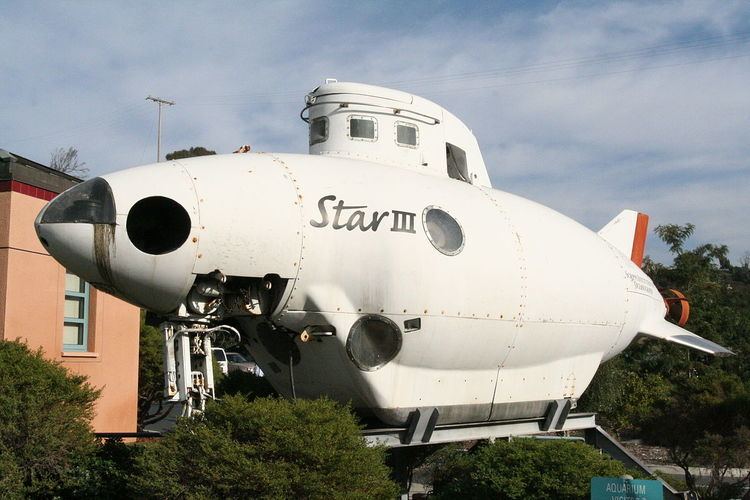 | ||
A submersible is a small vehicle designed to operate underwater. The term submersible is often used to differentiate from other underwater vehicles known as submarines, in that a submarine is a fully autonomous craft, capable of renewing its own power and breathing air, whereas a submersible is usually supported by a surface vessel, platform, shore team or sometimes a larger submarine. In common usage by the general public, however, the word submarine may be used to describe a craft that is by the technical definition actually a submersible. There are many types of submersibles, including both crewed and uncrewed craft, otherwise known as remotely operated vehicles or ROVs. Submersibles have many uses worldwide, such as oceanography, underwater archaeology, ocean exploration, adventure, equipment maintenance and recovery, and underwater videography.
Contents
History
The first underwater vessel was designed and built by American patriot David Bushnell in 1775 as a means to attach explosive charges to enemy ships during the American Revolutionary War. The device, dubbed Bushnell's Turtle, was an oval-shaped vessel of wood and brass. It had tanks that were filled with water to make it dive and then emptied with the help of a hand pump to make it return to the surface. The operator used two hand-cranked propellers to move vertically or laterally under the water. The vehicle had small glass windows on top and naturally luminescent wood affixed to its instruments so that they could be read in the dark.
Bushnell's Turtle was first set into action on September 7, 1776 at New York Harbor to attack the British flagship HMS Eagle. Sergeant Ezra Lee operated the vehicle at that time. Lee successfully brought the Turtle against the underside of Eagle's hull but failed to attach the charge because of the strong water currents.
Operation
Apart from size, the main technical difference between a "submersible" and a "submarine" is that submersibles are not fully autonomous and may rely on a support facility or vessel for replenishment of power and breathing gases. Submersibles typically have shorter range, and operate primarily underwater, as most have little function at the surface. Some submersibles operate on a "tether" or "umbilical", remaining connected to a tender (a submarine, surface vessel or platform). Submersibles have been able to dive to over 10 km (6 mi) below the surface.
Submersibles may be relatively small, hold only a small crew, and have no living facilities.
A submersible often has very dexterous mobility, provided by propeller screws or pump-jets.
Technologies
There are three basic technologies used in the design of submersibles. Single atmosphere submersibles (one atmosphere subs) have a pressurized hull and the occupants are at standard atmospheric pressure. This requires the hull to be capable of withstanding the high pressure from the water outside that is many times greater than the internal pressure.
Another technology called ambient pressure maintains the same pressure both inside and outside the vessel. This reduces the pressure that the hull has to withstand.
A third technology is the "Wet Sub", which refers to a vehicle that may or may not be enclosed, but in either case water floods the interior so SCUBA equipment is used to facilitate breathing. In both single atmosphere and ambient pressure subs, there is no need to use SCUBA equipment and occupants can breathe normally without wearing any equipment.
Deep-diving manned submersibles
Some submersibles have been able to dive to great depths. The Bathyscaphe Trieste was the first to reach the deepest part of the ocean, nearly 11 km (7 mi) below the surface, at the bottom of the Mariana Trench in 1960.
China, with its Jiaolong project in 2002, was the fifth country to send a man 3,500 meters below sea level, following the US, France, Russia and Japan. On June 22, 2012, the Jiaolong submersible set a deep-diving record when the three-person sub descended 22,844 feet (6,963 meters) into the Pacific Ocean.
Among the most well-known and longest-in-operation submersibles is the deep-submergence research vessel DSV Alvin, which takes 3 people to depths of up to 4,500 metres (14,800 ft). Alvin is owned by the United States Navy and operated by WHOI, and as of 2011 had made over 4,400 dives.
James Cameron made a record-setting, manned submersible dive to the bottom of Challenger Deep, the deepest known point of the Mariana Trench on March 26, 2012. Cameron's submersible was named Deepsea Challenger and reached a depth of 10,908 metres (35,787 ft).
Commercial submersibles
More recently, private firms such as Florida based Triton Submarines, LLC. SEAmagine Hydrospace, Sub Aviator Systems (or 'SAS'), and Netherlands-based U-Boat Worx have developed small submersibles for tourism, exploration and adventure travel. A Canadian company in British Columbia called Sportsub has been building personal recreational submersibles since 1986. They currently have models that will hold from one to eight occupants.
MROVs
Small unmanned submersibles called "marine remotely operated vehicles" or MROVs are widely used today to work in water too deep or too dangerous for divers.
Remotely operated vehicles (ROVs) repair offshore oil platforms and attach cables to sunken ships to hoist them. Such remotely operated vehicles are attached by a tether (a thick cable providing power and communications) to a control center on a ship. Operators on the ship see video images sent back from the robot and may control its propellers and manipulator arm. The wreck of the Titanic was explored by such a vehicle, as well as by a manned vessel.
